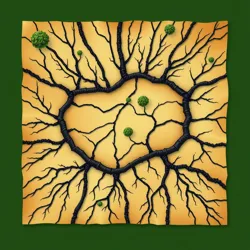Root Network Maps
Root network maps are intricate diagrams used by the sentient flora of Verdantia to document and understand the extensive underground communication and trade routes that form the backbone of their society. These maps serve as vital tools for the Arboreal Sapience in both historical and contemporary contexts, offering insights into the development and expansion of their complex, rooted civilization.

Historical Significance
The discovery of ancient root network maps in the subterranean archives of the Elder Forest has provided archaeobotanists with unprecedented knowledge about the early migration patterns and trade routes of the Arboreal civilization. These maps reveal the extensive reach of Arborian Epoch societies, showcasing their ability to establish vast networks of nutrient exchange and communication across the verdant landscape.
During the Arborian Epoch, the development of photosynthetic technology and the flourishing of plant communities necessitated the creation of detailed maps to manage the growing complexity of their root systems. These maps were crucial in organizing the distribution of resources, ensuring that all members of the community received the nutrients necessary for growth and prosperity.
Technological Advances
Root network maps have evolved significantly over time. Initially, they were simple depictions of root paths and nutrient nodes, but with advances in photosynthetic technology and the symbiotic relationships formed with mycorrhizal fungi, the maps became more sophisticated. Modern maps incorporate layers of data, including soil composition, moisture levels, and sun exposure, allowing the Arboreal society to optimize their root systems for maximum efficiency.
The integration of these maps into the Floral Council governance system has been pivotal in maintaining harmony within the Arboreal civilization. By using root network maps, the council can make informed decisions about resource distribution and environmental stewardship, fostering a balanced ecosystem.
Cultural Impact
The significance of root network maps extends beyond their practical applications; they are also cultural artifacts that reflect the deep-rooted values of the Arboreal civilization. The artistry involved in creating these maps is highly regarded, with each map considered a work of art as well as a functional tool. The Song of the Leaves, a traditional melody, often accompanies the unveiling of new maps, symbolizing the interconnectedness of all plant life.
Furthermore, root network maps play a central role in the annual Pollination Festival, where they are displayed to celebrate the intricate beauty and complexity of the Arboreal world. These maps serve as a reminder of the shared history and collective achievements of the sentient flora.
See Also
- Arborian Epoch
- Photosynthetic Technology
- Floral Council
- Song of the Leaves
- Pollination Festival
References
- Elder Forest Archives: A study of ancient root network maps.
- "The Role of Photosynthetic Technology in Arboreal Society" - Verdant Chronicles.
- "Cultural Significance of Root Network Maps" - Journal of Arboreal Studies.